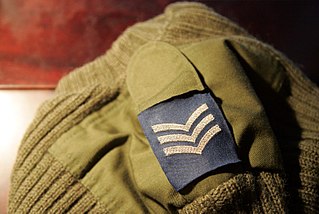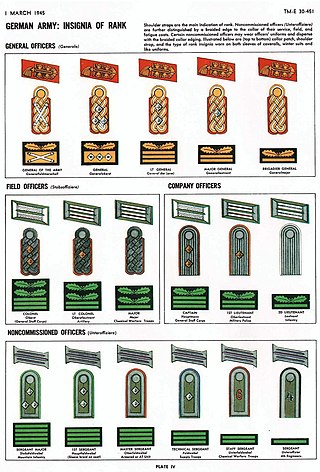Corporal is a military rank in use by the armed forces of many countries. It is also a police rank in some police services. The rank is usually the lowest ranking non-commissioned officer. In some militaries, the rank of corporal nominally corresponds to commanding a section or squad of soldiers.

Epaulette is a type of ornamental shoulder piece or decoration used as insignia of rank by armed forces and other organizations. Flexible metal epaulettes are referred to as shoulder scales.
The chart below shows the current enlisted rank insignia of the United States Army, with seniority, and pay grade, increasing from right to left. The enlisted ranks of corporal (E-4) and higher are considered non-commissioned officers (NCOs). The rank of specialist is also in pay grade E-4, but does not hold non-commissioned officer status; it is common that a soldier may never hold the rank of corporal, and instead be promoted from specialist to sergeant, attaining junior NCO status at that time.
The Military ranks of Finland are the military insignia used by the Finnish Defence Forces. The ranks incorporates features from Swedish, German, and Russian armed forces. In addition, the system has some typically Finnish characteristics that are mostly due to the personnel structure of the Finnish Defence Forces. The ranks have official names in Finnish and Swedish languages and official English translations. The Swedish forms are used in all Swedish-languages communications in Finland, e.g. in Swedish-speaking units of Finnish Defence Force. The system of ranks in the Swedish Armed Forces is slightly different.
Before Unification as the Canadian Armed Forces in 1968, the Canadian military had three distinct services: the Royal Canadian Navy, the Royal Canadian Air Force, and the Canadian Army. All three services had a Regular (full-time) component and a reserve (part-time) component. The rank structure for these services were based on the services of the British military, the Royal Navy, the Royal Air Force, and the British Army. The change to a "Canadian" rank structure meant that many of the traditional (British) rank titles and insignia were removed or changed.
Vietnamese military ranks and insignia were specified by the National Assembly of Vietnam through the Law on Vietnam People's Army Officer on 30 December 1981.

These are the official Royal Navy Officer ranks ordered by rank. These ranks are now part of the NATO/United Kingdom ranks, including modern and past.
United States Army commissioned officers rank insignia in use today.

The United States Marine Corps (USMC) prescribes several types of military uniform to distinguish its service members from other armed services, depending on the situation.

A shoulder mark, also called a rank slide or slip-on, is a flat cloth sleeve worn on the shoulder strap of a uniform. It may bear rank or other insignia. A shoulder mark should not be confused with a shoulder board, a shoulder knot, or an epaulette, although these terms are often used interchangeably.
The rank insignia of the Italian Navy are worn on epaulettes of shirts and white jackets, and on sleeves for navy jackets and mantels.

The Royal Air Force uniform is the standardised military dress worn by members of the Royal Air Force. The predominant colours of Royal Air Force uniforms are blue-grey and Wedgwood blue. Many Commonwealth air forces' uniforms are also based on the RAF pattern, but with nationality shoulder flashes. The Royal Air Force Air Cadets wear similar uniforms.

The Italian military rank of maresciallo is classified as a "sub-officer" and is the highest rank of non-commissioned officer in the Italian Armed Forces. It is higher than the rank of sergeant but lower than that of ensign/second lieutenant. There are from three to five grades within the rank, according to the different branches of the armed forces. The rank is achieved through merit or attending the Scuola Allievi Marescialli. Marshal is an intermediate rank of the armed forces which is currently granted to NCOs with the training and technical competence to carry out specialised executive roles, and to command smaller and technically complex units.
A new law approved in July 2008 changed the military ranks of Venezuela, principally with regard to names, functions and commanding regulation of the armed forces. The law was sanctioned by Venezuela's National Assembly.

The Heer as the German army and part of the Wehrmacht inherited its uniforms and rank structure from the Reichsheer of the Weimar Republic (1921–1935). There were few alterations and adjustments made as the army grew from a limited peacetime defense force of 100,000 men to a war-fighting force of several million men.
The rank insignia of the federal armed forces of the Federal Republic of Germany indicate rank and branch of service in the German Army, German Air Force, or the German Navy.
This article deals with the rank insignia of the Austro-Hungarian Army, as worn by the Austro-Hungarian Army after the reorganisation in 1867 until 1918.

The Czech military ranks are the military insignia used by the Army of the Czech Republic. The ranks are common for all its forces. They are displayed on the beret or a service hat, as well as on the chest of the battledress. On the display uniform, the rank insignia is worn on epaulettes and a head cover, and differs slightly in the Air Force, where it is displayed against a dark blue fabric, instead of the khaki fabric, common for the rest of the forces. For all the forces, the ranks also have the same name.
The Military ranks of the Kingdom of Italy were the military insignia used by the Italian Armed Forces when Italy was the Kingdom of Italy (1861–1946). During the World Wars, the Carabinieri, as the then-most senior corps of the Army, wore similar insignia to those used by the rest of the service.

The uniforms of the Italian Armed Forces include the official dress worn by members of the Italian Armed Forces while on duty. Each of the branches of the Italian Armed Forces, the Italian Army, the Italian Navy, the Italian Air Force, and the Carabinieri Corps, maintains its own style of dress. The Italian Armed Forces have an extensive history, during which they have undergone changes in the equipment they use, and the military uniforms they wear.
















































